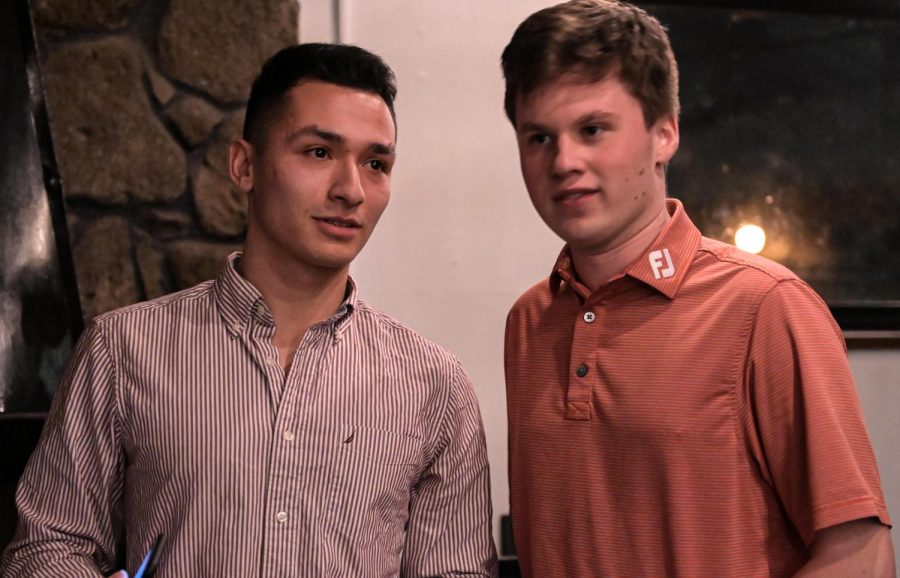ASWSU voices concern over tuition increase following move to online classes
University expenses increase with online format, WSU offical says; ASWSU President calls for transparency on where extra money will go
CAROLYNN CLAREY | DAILY EVERGREEN FILE
ASWSU President Curtis Cohen, left, said many students do not think a tuition increase is appropriate because of the switch to distance learning.
July 29, 2020
ASWSU is disappointed the university is going forward with a 2.5 percent tuition increase following WSU’s announcement that classes will be moved online.
WSU is spending more money to move to an online format than the university would be spending for face-to-face classes, said Phil Weiler, WSU’s Vice President for Marketing and Communications.
ASWSU published a letter July 27 expressing concern about the tuition increase in the middle of a pandemic, said ASWSU President Curtis Cohen.
Many students do not think a tuition increase is appropriate because of the switch to distance learning. Cohen said a tuition freeze would have been acceptable, given that WSU is losing a considerable portion of money from the state.
“Students don’t see the value of paying more for what, perceivably, is less of a collegiate experience,” he said.
When WSU was still planning on holding in-person classes, Cohen said ASWSU members understood the tuition increase. This is because they realized it would cost the university more to ensure proper safety precautions, like personal protective equipment.
WSU is reducing its budget by $37.2 million as required by the state, Weiler said. Washington typically gets most of its revenue from sales tax. Unfortunately, COVID-19 has decreased the amount of commercial activity, and as a result, sales tax revenue has fallen. This year, Washington has not been able to receive enough money to pay for certain things it can typically afford.
Weiler said most tuition money goes toward faculty salaries. WSU also has to pay for technology like Zoom or Panopto so faculty members can teach classes online.
The university also provided training for faculty members to learn how to teach online, he said. Learning specialists helped faculty members determine how to change a face-to-face curriculum to an online one.
“We have invested millions of dollars to be able to support students as we make this change,” Weiler said.
In March, WSU gave out hundreds of Chromebooks to students whose computers were not high quality enough for online learning, he said.
WSU has created more than 600 Wi-Fi hotspots for students who could not afford it or whose Wi-Fi is not good enough for distance learning, he said. The university will continue to pay for these hotspots next semester. WSU created Wi-Fi capability for campus and research center parking lots too.
The university lost money last semester when WSU Housing and Dining gave back $11 million to students who left residence halls early. In the upcoming semester, it is expected that Housing and Dining will lose $40 million because there will be fewer people on campus, he said.
“This is a time when we are losing revenue and having additional expenses,” Weiler said. “We just are not in a position to say, ‘We’re going to reduce tuition.’”
He said university officials understand students may not have been able to find summer jobs and use that money for school. They also recognize students’ family members might have lost employment.
WSU officials decided the university cannot reduce tuition and still be able to provide quality education, Weiler said.
Cohen said WSU could have done more to ensure students knew about the potential tuition increase before it happened. The ASWSU letter stated changes that can be made in the future so students can be more informed.
“I think a lot of students weren’t fully aware of the tuition increase until it actually happened,” Cohen said.
He said he thinks this issue shows the lack of transparency of where tuition money actually goes. He would like WSU to have a document showing what the 2.5 percent increase will be funding.
“Now we know we’re going to see significant hits in our revenue, and that 2.5 [percent tuition increase] is not going to get us ahead,” Weiler said. “It’s going to get us closer to the breakeven point, but still, we’re going to be spending a lot more money to educate students this semester than we’re going to be bringing in.”
WSU is reevaluating mandatory fees because there will be fewer students on campus, Weiler said. If WSU refunds fees, the money will have to be taken from a reserve account.
To help students next semester, a student guide is available with instructions and tips for using online tools. There will also be live training about the tools starting Aug. 3.










